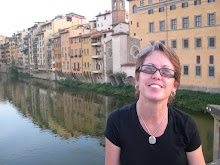 |
| The gallery built over the river |
There are of course the rooms for the King (Henri II), the Queen, and the King’s “favorite lady,” Diane de Poitiers, who had the bridge build upon which Catherine de’Medici built the gallery. But the most interesting room is that of Louise of Lorraine, who, after the death of her husband, King Henri III, took up residence at Chenonceau surrounded by nuns, and spent the last 11 years of her life in mourning. Always dressed in white, the protocol for royal mourning, she was dubbed the White Queen. Her room is black: ceiling, walls, drapery, even the linens upon her bed.
There is also a 16th century farm; a great example of how growing food can be beautiful as well as practical with flowers and vegetables growing side-by-side.
For more pictures of Chateâu de Chenonceau, the gardens, and farm click here.














 Posted by
Posted by


No comments:
Post a Comment